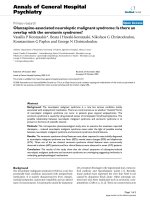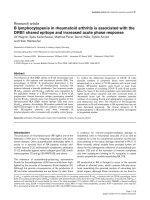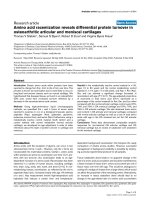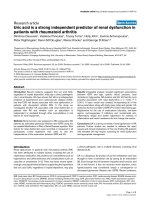Báo cáo y học: "Tranexamic acid in cardiac surgery: is there a cause for concern" pps
Bạn đang xem bản rút gọn của tài liệu. Xem và tải ngay bản đầy đủ của tài liệu tại đây (113.91 KB, 2 trang )
A recent article from the group in Berlin [1] reports on a
retrospective review of observational data comparing
their experience using tranexamic acid as an enforced
alternative to aprotinin. eir data suggest an increase in
morbidity and mortality in the tranexamic acid treated
patients. Is this a cause for concern and what does it
mean for the future?
e voluntary withdrawal of aprotinin in certain
markets has had two major eff ects. e fi rst was to cause
all of the safety and effi cacy data for aprotinin to be
independently examined by regulatory authorities in
both North America and Europe. is process is coming
to its conclusion and it is anticipated that, based on a
positive benefi t-risk ratio, the Canadian authority will
renew the marketing license for aprotinin before the end
of this year. e European agency is also starting a review
[2] but it is not anticipated this process will be completed
until 2011.
e second eff ect of the withdrawal of aprotinin was
that clinicians had to fi nd an alternative blood-sparing
agent for use during major cardiac surgery. e two alter-
na tives are the lysine analogues epsilon aminocaproic
acid and tranexamic acid. Epsilon aminocaproic acid has
no approval in Europe or Canada for human adminis-
tration, leading to the exclusive use of tranexamic acid in
these countries.
is shift highlighted a number of problems concerning
tranexamic acid. e fi rst was to defi ne an appropriate
eff ective dose. ere is only one study investigating a
dose-response relationship [3]. is article showed a
plateau eff ect on drains losses with a total dose of 3 grams
tranexamic acid but with no observed eff ect on trans fu-
sions. e population studied were patients having low-
risk primary myocardial revascularisation. e second
problem is that there is no evidence for a benefi t of
tranexamic acid to reduce transfusion burden in patients
at higher risk for transfusions, such as those taking
aspirin prior to surgery [4] and those having prolonged
bypass periods associated with more complex, typically
combined valve and revascularisation surgery. e
current article [1] mirrors a meta-analysis showing re-
exploration for bleeding is reduced by aprotinin but not
tranexamic acid in such patients [5]. Finally, and of
crucial importance, there have never been any specifi cally
powered studies to investigate the safety of tranexamic
acid.
Over the past months a number of articles have
suggested the use of tranexamic acid is not without risk.
In an extension of a previous analysis from Toronto, the
authors concluded that mortality after cardiac surgery
other than primary revascularisation was greater in those
patients given tranexamic acid compared to those given
high dose aprotinin [6]. An increase in mortality when
tranexamic acid was given instead of aprotinin is also a
conclusion from the current article [1].
Neurological outcomes is a long standing safety
concern as we know administration of tranexamic acid is
associated with clinically signifi cant cerebral vasospasm
with acute cerebral haemorrhage [7]. e current article
[1] shows a three-fold increase in patients having seizures
who were allocated to receive high dose tranexamic acid
as part of their management during surgery where a
Abstract
The withdrawal of marketing approval for aprotinin
resulted in more clinicians administering tranexamic
acid to patients at increased risk of bleeding and
adverse outcome. The latest in a series of retrospective
analyses of observational data is published in Critical
Care and suggests an increase in mortality, when
compared to data from the aprotinin era, in those
patients having surgery when a cardiac chamber
is opened. The added observation of an increase
in cerebral excitatory phenomena (seizure activity)
with tranexamic acid has a known mechanism and
questions if such patients should be given this drug.
© 2010 BioMed Central Ltd
Tranexamic acid in cardiac surgery: is there a cause
for concern?
David Royston*
See related research by Sander et al., />COMMENTARY
*Correspondence:
Royal Brompton and Hare eld NHS Foundation Trust, Hare eld, Middlesex,
UB96JH, UK
Royston Critical Care 2010, 14:194
/>© 2010 BioMed Central Ltd
cardiac chamber was opened. Can this observation be
causally associated with tranexamic acid administration?
e statistical analysis used in the current study was
similar to that used to show a deleterious eff ect of
aprotinin, which has subsequently been shown to be
fl awed. However, an analysis error seems less likely in this
case for two reasons. First, a potential mechanism for
altering the excitatory neuronal state is recognised. e
lysine analogues have marked structural homology with
gamma amino butyric acid (GABA) and act as
competitive inhibitors in the central nervous system
[8,9]. is inhibition is observed clinically as an increase
in seizure activity [9,10]. Second, several other groups
have independently made the observation of increased
seizure activity, mainly in patients having open cardiac
chamber procedures [11,12].
What can and should happen next? e European
regulatory authority is currently deliberating on not only
the licensing for aprotinin but also tranexamic acid [2].
With the increasing body of evidence, it is becoming
clearer that aprotinin therapy is of greatest benefi t in
patients at highest risk (the originally intended patient
population [13]). e data also suggest that tranexamic
acid in a dose of about 3 to 5 grams may be useful to
reduce transfusion burden in patients not taking platelet
active medication and having primary myocardial
revascularisation. is patient population appears not to
have observed safety issues when tranexamic acid was
administered [5]. e current study adds to the data
questioning if tranexamic acid administration has a place
in higher risk cardiac surgery and especially in surgery
where a cardiac chamber is opened.
Competing interests
In the past 5 years DR has acted as a paid consultant to Bayer Schering,
Cubist and Curacyte, the pharmaceutical companies who have the potential
blood-sparing agents aprotinin under review and Eccallentide and CU 2010
respectively under development.
Published: 6 September 2010
References
1. Sander M, Spies CD, Martiny V, Rosenthal C, Wernecke KD, von Heymann C:
Mortality associated with administration of high-dose tranexamic acid
and aprotinin in primary open-heart procedures: a retrospective analysis.
Crit Care 2010, 14:R148.
2. EMA [www.ema.europa.eu/pdfs/human/press/pr/10757010en.pdf]
3. Horrow JC, Van Riper DF, Strong MD, Grunewald KE, Parmet JL: The dose-
response relationship of tranexamic acid. Anesthesiology 1995, 82:383-392.
4. McIlroy DR, Myles PS, Phillips LE, Smith JA: Anti brinolytics in cardiac
surgical patients receiving aspirin: a systematic review and meta-analysis.
Br J Anaesth 2009, 102:168-178.
5. Henry D, Carless P, Fergusson D, Laupacis A: The safety of aprotinin and
lysine-derived anti brinolytic drugs in cardiac surgery: a meta-analysis.
CMAJ 2009, 180:183-193.
6. Karkouti K, Wijeysundera DN, Yau TM, McCluskey SA, Tait G, Beattie WS: The
risk-bene t pro le of aprotinin versus tranexamic acid in cardiac surgery.
Anesth Analg 2009, 110:21-29.
7. Fodstad H, Forssell A, Liliequist B, Schannong M: Anti brinolysis with
tranexamic acid in aneurysmal subarachnoid hemorrhage: a consecutive
controlled clinical trial. Neurosurgery 1981, 8:158-165.
8. Barker JL, Nicoll RA, Padjen A: Studies on convulsants in the isolated frog
spinal cord. I. Antagonism of amino acid responses. J Physiol Lond 1975,
245:521-536.
9. Furtmüller R, Schlag MG, Berger M, Hopf R, Huck S, Sieghart W, Redl H:
Tranexamic acid, a widely used anti brinolytic agent, causes convulsions
by a gamma-aminobutyric acid(A) receptor antagonistic e ect.
JPharmacol Exp Ther 2002, 301:168-173.
10. Fe er SE, Parray HR, Westring DW: Seizure after infusion of aminocaproic
acid. JAMA 1978, 240:2468.
11. Martin K, Wiesner G, Breuer T, Lange R, Tassani P: The risks of aprotinin and
tranexamic acid in cardiac surgery: a one-year follow-up of 1188
consecutive patients. Anesth Analg 2008, 107:1783-1790.
12. Murkin JM, Falter F, Granton J, Young B, Burt C, Chu M: High-dose tranexamic
Acid is associated with nonischemic clinical seizures in cardiac surgical
patients. Anesth Analg 2010, 110:350-353.
13. Royston D, Bidstrup BP, Taylor KM, Sapsford RN: E ect of aprotinin on need
for blood transfusion after repeat open-heart surgery. Lancet 1987,
2:1289-1291.
doi:10.1186/cc9227
Cite this article as: Royston D: Tranexamic acid in cardiac surgery: is there a
cause for concern? Critical Care 2010,
14:194.
Royston Critical Care 2010, 14:194
/>Page 2 of 2









